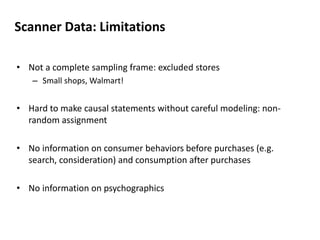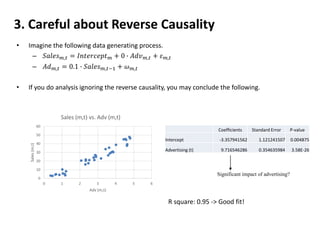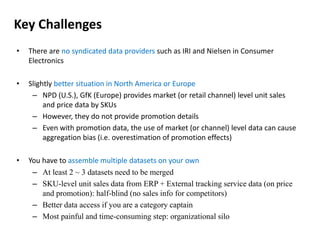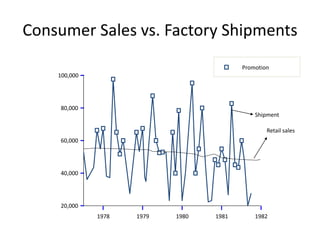Promotion Analytics in Consumer Electronics - Module 1: Data
- 1. Workshop Overview • Module 1: Data • Module 2: Model and Estimation • Module 3: Sample Output and Empirical Generalization
- 2. Outline • Ideal Data for Promotion/Pricing Analytics: Scanner Data (in CPG) • Data and Inference: What Can Go Wrong? • Challenges and Common Mistakes in Consumer Electronics • Data Requirement and Potential Data Source
- 3. Scanner Data (Store Audit Data) How is Data Collected? • Syndicated data providers: IRI and A.C. Nielsen • Sample of stores (Grocery, Drug, Convenience, Mass Merchandiser, Warehouse stores) • Scanner data – UPC info (product features), (Retail) price, Quantity (Volume) all recorded • Features – Centrally collected and coded (daily) • Displays – Collected by store auditors (1X/week)
- 4. 4 Data Dimensions • The Data Cube – Geography (Market) x Product x Time x Variable (Measure) – G x P x T x V > 1,000,000 even for one category • Aggregation (chain/regions, SKU groups, temporal)
- 5. Scanner Data: Advantages • Completeness – Linking aggregate sales movements to marketing instruments (price, feature, display, etc) – Obtaining a richer set of performance measures beyond market share and factory shipments • Timeliness – Getting the data within a window that allows for meaningful managerial action (i.e. less than old lag time of 8 weeks or more) • Accuracy
- 6. Scanner Data: Limitations • Not a complete sampling frame: excluded stores – Small shops, Walmart! • Hard to make causal statements without careful modeling: non-random assignment • No information on consumer behaviors before purchases (e.g. search, consideration) and consumption after purchases • No information on psychographics
- 7. Promotion Analytics from Scanner Data 5 % Week 8 % 4.5 % 4.8 % 1 2 3 4 5 6 7 8 Promotion Week Purchase Deceleration Purchase Acceleration Net Effect = (8 - 5) - .2 - .5 = 2.3% • A simplistic picture
- 8. Promotions: Actual data 5 10 15 20 25 30 Week 1 0.8 0.6 0.4 0.2 Market Share 1 0.75 0.5 0.25 Price F D C F D C F D F D C F D C F D F D F = Feature, D = Display, C = Store Coupon
- 9. Promotion Types (End of Aisle) Display Feature Price-cut (BOGO) Coupon
- 10. 1. Size of Data Information in Data • Consider the following two options: (1) Wal-Mart with 4,000 stores, 52 weeks of data, 500 SKUs (104 million observations!) (2) Best-buy with 1,500 stores, 52 weeks of data, 500 SKUs (39 million observations) • Which dataset would be more useful to measure price responses? 25 20 15 10 5 0 Wal-Mart (EDLP) 1 3 5 7 9 11 13 15 17 19 21 23 25 27 29 31 33 35 37 39 41 43 45 47 49 51 P1 P2 P3 25 20 15 10 5 0 Best-Buy (Hi-Lo) 1 3 5 7 9 11 13 15 17 19 21 23 25 27 29 31 33 35 37 39 41 43 45 47 49 51 P1 P2 P3
- 11. 2. Pay Attention to Signal-to-Noise Ratio • Consider the following measurement. Is there significant impact from marketing event? Revenue Before Event After Event % Change Average 10 13 30 • Well, it depends on signal-to-noise ratio! 16 14 12 10 8 6 4 2 0 Revenue before/after Event 0 20 40 60 80 100 120 120 100 80 60 40 20 0 Revenue before/after event 0 20 40 60 80 100 120
- 12. 3. Careful about Reverse Causality • Imagine the following data generating process. – 푆푎푙푒푠푚,푡 = 퐼푛푡푒푟푐푒푝푡푚 + 0 ∙ 퐴푑푣푚,푡 + 휀푚,푡 – 퐴푑푚,푡 = 0.1 ∙ 푆푎푙푒푠푚,푡−1 + 휔푚,푡 • If you do analysis ignoring the reverse causality, you may conclude the following. 60 50 40 30 20 10 0 Sales (m,t) vs. Adv (m,t) 0 1 2 3 4 5 6 Sales (m,t) Adv (m,t) Coefficients Standard Error P-value Intercept -3.357941562 1.121241507 0.004875 Advertising (t) 9.716546286 0.354635984 3.58E-26 Significant impact of advertising? R square: 0.95 -> Good fit!
- 13. 4. Omitted Variables Can Be Dangerous • Oftentimes, we don’t have data on some important variables, which can impact sales, revenue, or profits. – Doing analytics ignoring these “omitted variables” can lead to “biased” estimates of marketing mix effects. • Think about the graph below (from NYT). Is the family income really responsible for better academic achievement? What would be potential omitted variable bias here?
- 14. 5. Selection by Outcome: Bad Idea! • Problem: Often times, two groups, which are conditioned by outcome variables, are compared to infer the causal impact of marketing mix • Example – To calculate the ROI of paid search campaign, advertisers compare the “conversion rates” of each “search” keyword. Usually, branded keywords are shown to have high conversion rates (> 6%) compared to generic keywords (~ 1%). • How to fix the problems? – Use proper “control” condition! – In the paid search example, all the traffics/conversions from consumers who click on branded keywords are attributed to the resulting sales and profit. An implicit assumption here is that all the sales/profits are lost without paid search. Really? – It’s possible that consumers who use branded keywords are already quite committed to purchase, and they may simply substitute to unpaid (organic) search links if paid searches are turned off. – A proper control in this case is “halting selected search engine marketing keywords”
- 15. Key Challenges • There are no syndicated data providers such as IRI and Nielsen in Consumer Electronics • Slightly better situation in North America or Europe – NPD (U.S.), GfK (Europe) provides market (or retail channel) level unit sales and price data by SKUs – However, they do not provide promotion details – Even with promotion data, the use of market (or channel) level data can cause aggregation bias (i.e. overestimation of promotion effects) • You have to assemble multiple datasets on your own – At least 2 ~ 3 datasets need to be merged – SKU-level unit sales data from ERP + External tracking service data (on price and promotion): half-blind (no sales info for competitors) – Better data access if you are a category captain – Most painful and time-consuming step: organizational silo
- 16. Common Mistakes: For Discussion • Use factory shipment data instead of retail sales data – Biased promotion effect estimates due to forward buying from retailers • Use cross-sectional data to measure price/promotion effects – Biased price or promotion effect estimates due to omitted variable bias – Better to use panel data and identify effects from within-store (or within chain) variation • Use market (or channel) level data – Promotion effects are not homogeneous within a market (or channel) – Due to aggregation bias, promotion effects will be overstated – Better to use store, account, or chain-level data where promotion activities do not vary across units • Use data with short history (1 year or less) – At least, 2 ~ 3 years of data are required to properly measure seasonality • Ignore price changes and promotion from competitors – Biased estimates of baseline sales and price/promotion effects
- 17. Consumer Sales vs. Factory Shipments 100,000 80,000 60,000 40,000 20,000 Promotion Shipment Retail sales 1978 1979 1980 1981 1982
- 18. Data Requirement • Key elements of data – Unit sales by SKUs (outcome): ideally for the entire category (including competitors), but feasible only with data for focal company‘s own SKUs – Price measures by SKU(causal): focal company + competitors – Promotion measures by SKU/product line/brand (causal): focal company + competitors • Duration – Ideally 3 years (of weekly data); At least 2 years of data – To properly control seasonality • Level of aggregation – Ideally store-level data; chain or account (chain-market combination) data can be used as long as promotion/price policies are uniform (within chain or account) – Using market or channel-level data can cause overstating of promotion effects due to aggregation bias • Type of response data: Retail sales data (Do not use factory shipment data) – Due to forward buying from retailers
- 19. Potential Data Source: For Discussion • Key elements of data – Unit sales by SKUs (outcome) – Price measures by SKU(causal) – Promotion measures by SKU/product line/brand (causal)



















